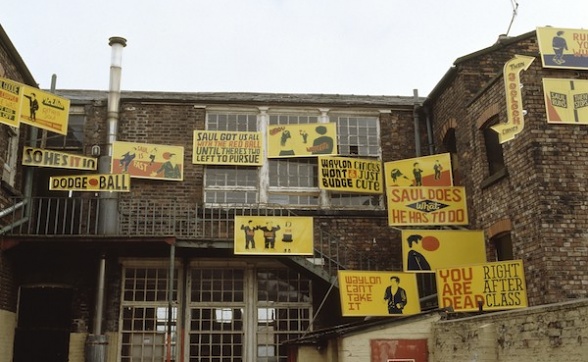Stephen Powers
Stephen Powers, Waylon Saul, 2002
Stephen Powers (b. 1968, Philadelphia) has been a central figure in the graffiti movement since the late 1980s, painting in his native West Philadelphia and in New York City where he now lives and works. Whilst at the University of Arts he established the graffiti and hip-hop lifestyle magazine On the Go, publishing sixteen issues between 1991-97.
In 1999 he wrote The Art of Getting Over (St Martin’s Press), a book that documents the role of graffiti art in New York and Philadelphia. The period in which Powers has been operating as a graffiti writer has seen a huge clean up by the authorities (particularly in New York) of the spaces used by graffiti writers, which has led them to find other surfaces and contexts to work within, a move in which graffiti magazines have played an important part. Powers has built his tag ESPO into a brand, mimicking the visual language and machinery of advertising and retail; in the late 1990s his writing has focused particularly on storefront roll-downs adorned with a clear graphic tag, which he describes as ‘brand positioning’. This interest in logo and branding as identity has continued into his more recent gallery work where he has developed an equivalent for his graffiti-writing rather than simply transferring the street work into the gallery space.
In 2000 he collaborated with Todd James/REAS, and Barry McCee/TWIST for Indelible Market (Institute of Contemporary Art, Philadelphia), which later transformed into Street Market (Deitch Projects, New York and the Biennale di Venezia 2001). The installation, described by Powers as a ‘bodega of ideas’, created an imaginary chaotic commercial network of storefronts and advertising signage into which the brand name ESPO was incorporated.
Signs were fabricated promoting ‘ESPO Handmade Myth’ or ‘ESPO Supreme Quality’, declaring an ironic twist on the commercialism of the art market with slogans such as ‘he has a great look for a famous artist’. McCee and James also participated in the International 2002, but in this instance the three artists created three separate projects shown alongside each other.
For the International 2002 Powers created a new work, Waylon Saul (2002), for the schoolyard of Pleasant Street Board School, comprising more than thirty painted panels hung across the walls of the school building. The work continued Powers’ practice of using the aesthetics of commercial sign writing – a visual language integral to the experience of the city, but often overlooked in its familiarity – to create narratives portraying the realities of contemporary urban life. In this instance, the site was a disused primary schoolyard and inspired the story of Saul Goode which the artist described as ‘the story of a schoolyard bully who finds himself in a showdown with the weakest kid in class. The weakling turns the tables and ultimately wins the day with the weapon of laughter’. Powers hoped that the story ‘serve[d] as a useful meditation on the necessity of levity in overcoming the struggles in the schoolyard and around the world’.
Stephen Powers at Liverpool Biennial 2002
Waylon Saul, 2002
Sign enamel on aluminium
Courtesy of the artist
Commissioned by Henry Moore Foundation Contemporary Projects
Exhibited at Pleasant Street Board Room
Liverpool Biennial
55 New Bird Street
Liverpool L1 0BW
- T +44 (0)151 709 7444
- info@biennial.com
Liverpool Biennial is funded by
Founding Supporter
James Moores
